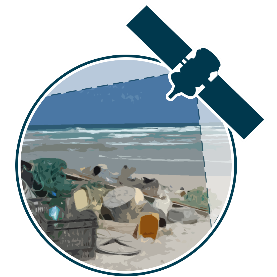Each year an estimated 8 million tons of plastic enters the oceans from land. Plastic persists in the environment for very long times (centuries) and can disappear from the sea surface by sinking to the bottom, beaching, degradation, and ingestion by animals. While ultraviolet light of the sun and chemicals dissolved in seawater degrade the plastic, breaking waves and collisions fragment plastic litter items into smaller and smaller pieces and finally into microplastics. Exactly what happens to marine plastic litter is uncertain as global budgeting exercises find significantly less material on the ocean surface than expected. More than 99% is “lost”. Remote sensing (the science of obtaining information about objects or areas from a distance, typically from aircraft or satellites) has the potential to provide long-term, global monitoring. Remote sensing of marine plastic litter is still in early stages and most progress has been made in the field of spectral remote sensing where optical physics applies. It has become clear that optical spectral remote sensing would benefit from complementary measurements using different sensing technologies.
Last year, the European Space Agency (ESA) invited businesses, universities, organisations or individuals with an idea for achieving more through space research to reach for the stars and submit novel ideas to detect and track marine plastic litter using satellite. This summer, the 26 highest evaluated projects have been kicking off as a result and the ERI was successful with their idea to monitor marine plastic pollution based on thermal infrared (TIR) sensing. Their 18-month project “Thermal Infrared Sensing for marine Plastic Litter” (TISPLALI) is led by ERI’s Dr. Lonneke Goddijn-Murphy. Although the 26 projects cover a wide range of different problems, solutions, approaches and geographical areas, there are places where the different teams will cooperate and build upon each other’s work.
See the update from ESA here (make sure to check in the future for TISPLALI update): A step forward in detecting plastic marine litter from space
The idea to study the potential of measuring TIR radiance as a novel remote sensing technology for floating plastic litter is based on the different emissivity- and surface temperature values of water and plastic. We plan to verify our thermal radiance model for floating plastic litter using airborne longwave infrared (LWIR) cameras, and measurements in the laboratory. In addition, we will use airborne cameras in the near infrared and visible spectrum to evaluate how the TIR images could complement measurements in the optical spectrum. Our findings could apply to satellite observations of marine plastic pollution, helping to explain how 99% has disappeared. Our research could also inform spaceborne and airborne missions assisting marine plastic litter clean-up efforts. Other examples of applications are, evaluating plastic litter reducing policies and supporting particle tracking models by locating sources and pathways of marine plastic litter.

For more information, visit the OSIP website
